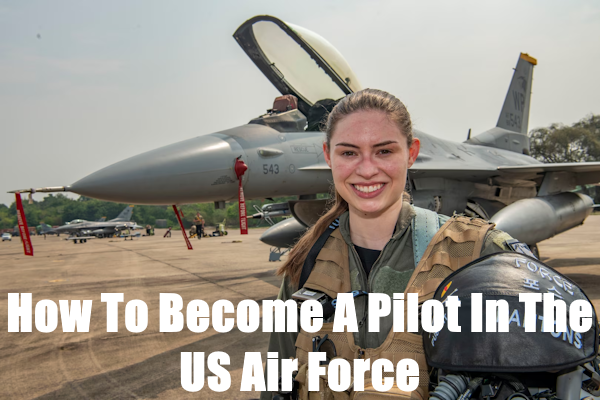Are you interested in becoming an Air Force pilot?
There are multiple steps you must follow in order to join the Air Force flight program.
However, the time and effort is worth it.
U.S. Air Force pilots are among the most skilled and respected in the field of aviation.
Find out how to become an Air Force pilot by following these 6 simple steps.
Related Article – Military Pilots Salary: Here’s How Much Fighter Pilots Make
Table of Contents
How to Become a U.S. Air Force Pilot
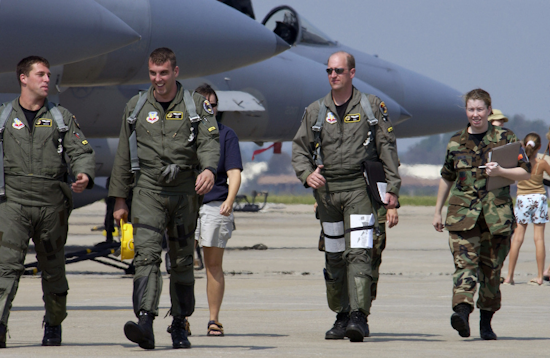
The United States Air Force (USAF) is the world leader in aviation.
The military branch is responsible for aerial combat, transportation, and surveillance.
Additionally, Air Force pilots operate some of the most advanced military aircraft in the world.
For this reason, Air Force pilots are extremely well-trained and prepared for the job role.
Accordingly, new candidates must complete several steps in order to join the U.S. Air Force as a pilot:
- Earn a college bachelor’s degree.
- Apply to join the U.S. Air Force
- Meet Air Force pilot requirements and qualifications.
- Complete USAF Basic Officer Training School.
- Attend and complete Air Force Flight School.
- Serve 10-year active duty service with the U.S. Air Force.
Air Force pilots control aircraft such as fighter jets, bombers, tankers, and transport planes.
Furthermore, there is an increased need for Air Force Unmanned Aerial Vehicle (UAV) Operators.
Air Force pilots must meet demanding academic, physical, visual, and medical requirements (more information, below).
Discover the 6 steps necessary to become a United States Air Force pilot.
Related Article – Air Force Helicopter Pilot: Requirements, Training, & More
#1. Earn a College Degree (Bachelor’s)
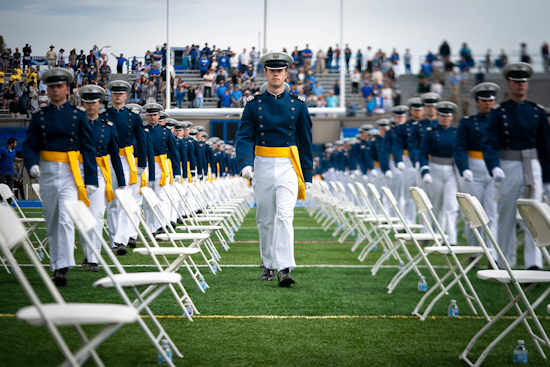
There are multiple pathways available to become an Air Force pilot.
First, candidates must finish high school and attend a 4-year college or university.
Then, pilots must become commissioned officers in the Air Force.
There are several pathways to receiving a 4-year degree, and two of them provide a more direct pathway to a USAF commission.
Air Force Academy (USAFA)
The Air Force Academy is a federally funded service academy that combines a college education with military training.
USAFA is tuition-free and provides a direct route to an Air Force commission, and hopefully, Undergraduate Pilot Training (UPT) for those who qualify.
However, competition for admission is fierce, and the Academy only takes the best of the best.
You can find out more about how to get into the Air Force Academy here.
Air Force Reserve Officer’s Training Corps (AFROTC)
Both high school and current college students may qualify to join the Air Force ROTC program.
AFROTC is active in over 1,100 schools across the nation.
The USAF ROTC program offers scholarships that help to cover tuition costs, as well as providing a monthly living stipend that allows students to focus on their studies.
ROTC students must be pursuing a Bachelor of Science degree in STEM majors that include everything from Avionics to Textile Engineering.
Enlisted Airmen are also eligible for several AFROTC scholarships and commissioning programs. You can find out more about them here.
College Students and College Graduates
If you aren’t eligible for the two options above or have already completed your 4-year degree, your next step is to make sure you meet the USAF commissioning requirements.
Next, it’s time to talk to a recruiter.
#2. Meet Air Force Pilot Requirements / Qualifications
There are many different requirements that candidates must meet in order to qualify.
First, prospective Air Force pilots go through a series of examinations and investigations to make sure they meet the following physical specifications:
- Be a U.S. citizen able to meet all requirements and pass a selection board prior to the age of 33.
- Meet Air Force height and weight requirements, which are >26% BFM (men) / >36% (women)
- Demonstrate physical fitness for duty
- Meet USAF height limitations, which have historically been between 5’4″ and 6’5″.
- Have no history of hay fever, asthma, or allergies after age 12.
- Demonstrate normal color vision
- Have near visual acuity of 20/30 without correction and distance visual acuity of no worse than 20/70 in each eye, correctable to 20/20.
- Meet refraction, accommodation and astigmatism requirements — LASIK and PRK surgery are generally now accepted after recovery.
- Have or be within 365 days of receiving a baccalaureate degree (BA or BS) in any major with a GPA of at least 2.5.
- Take the Air Force Officer Qualification Test and score a minimum of 15 Verbal, 10 Quantitative, and 25 Pilot.
The U.S. Air Force does not require that pilots obtain a degree in aviation or aerospace engineering.
Air Force pilots must be in great health and usually are absent of any major or preexisting health conditions. You’ll receive a full Class-A flight physical will be performed before attending UPT.
Note that the height limits are purely functional restrictions and aren’t medical in nature.
In 2020, the Air Force switched to using anthropometric measurements to determine a candidate’s ability to function effectively in the cockpit. These include your sitting eye height, buttocks to knee length, and arm span.
If you’re outside the listed height span, you’ll be tested on the anthropometric device during your flight physical at Wright Patterson AFB, OH.
For those at the U.S. Air Force Academy, a specialty team conducts the measurements for qualification.
Related Article – High School to Flight School: Army “Street To Seat” Program Explained
#3. Join the United States Air Force (USAF)
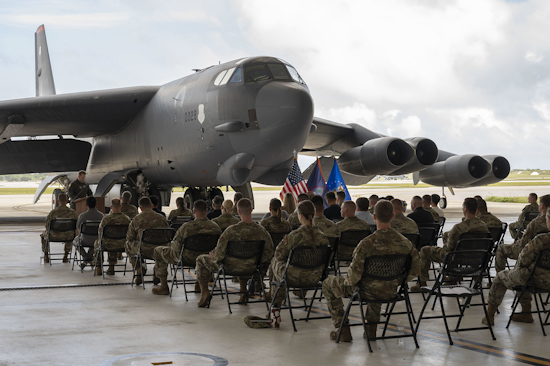
There are numerous branches of the U.S. Armed Forces worth considering.
However, the Air Force (USAF) offers many many advantages including one of the top flight schools (more details, below) in the world.
Nevertheless, before you get too far, you’ll want to consider contacting a military recruiter.
The military recruiter can assist those interested in joining the Air Force with the necessary steps to become a pilot.
Recruiters understand the eligibility requirements and can also explain the multiple flying roles in the Air Force.
Moreover, applicants to the flight program must perform well on a series of exams, including the AFQT.
Basic Requirements
Candidates generally have to pass a Single Scope Background Investigation (SSBI) with the Department of Defense (DoD).
Furthermore, a criminal record or previous drug use may also serve as grounds for disqualification.
After completing all the basic requirements, candidates are placed into the Delayed Entry Program (DEP) to await an opening at Officer Training School.
Note that officer candidates selected for UPT will have a 10-year service commitment after graduation (more information, below).
Job Specific Skills
It doesn’t hurt to have a knowledge of the theory of flight, air navigation, and aircraft operating procedures prior to admission.
Moreover, relevant skills include having the ability to think critically and solve complex problems.
Math and reasoning skills are especially helpful as are active listening skills and the ability to learn and adapt.
Vision Requirements
More importantly, the aspiring pilot needs to have at least 20/30 vision in both eyes without correction and distance visual acuity of no worse than 20/70.
Ultimately, the vision must be corrected to 20/20 in order to remain qualified.
The Air Force also requires that prospective pilots are not colorblind and do not suffer from poor depth perception (minimum 20/200 for distant vision).
Not long ago, laser eye surgery generally disqualified candidates from the flight program. However, both PRK and LASIK surgery are accepted or waivable.
Related Article – Commissioned Officer Vs. Non-Commissioned Officer (NCO): 5 Major Differences
#4. Officer Basic Training School (OTS)
Air Force Officer Training School (OTS) is generally the next step after candidates earn a college degree.
OTS is located at Maxwell AFB, AL, and lasts for 8.5 weeks. The program includes 30 hours of distance learning, as well as military training and leadership development.
The curriculum at OTS focuses on Air Force history and customs along with military professionalism and bearing.
Candidates attend lectures and get hands-on experience during a number of field exercises during OTS.
Management concepts and techniques round off the program, with an emphasis on team-building, creative thinking, and decision-making.
Physical condition also plays a role at Officer Training School, and those attending must pass the Air Force Physical Fitness Test.
Then, upon completion, candidates receive their officer commission and progress to Air Force Specialized Undergraduate Pilot Training.
AFROTC and USAFA Graduates
However, those who earned their degrees through AFROTC or USAFA bypass Officer Training School and go straight to their first job-specific training or first duty assignment.
A significant part of the curriculum for these two programs involves professional military education and physical conditioning.
If you applied and were selected for UPT during AFROTC or USAFA, your first duty assignment would be reporting to UPT.
Related Article – Air Force Officer Training School (OTS) Guide
#5. Air Force Pilot Flight Training
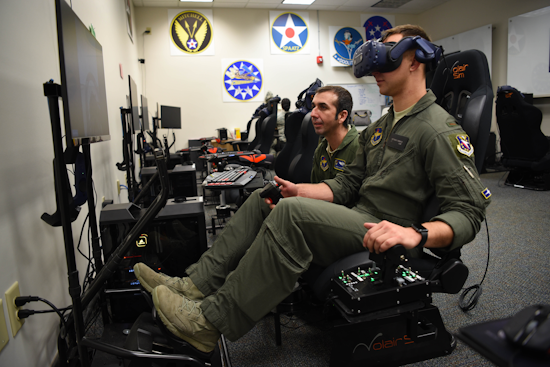
The first step to becoming an Air Force pilot after OTS is your Initial Flight Training (IFT) at Pueblo, Colorado.
This two-month program includes ground school as well as rudimentary flight hours.
There is a lot of emphasis on memorizing procedures, known as your Boldface. Overall, it’s an intense introduction to follow-on pilot training.
Air Force Specialized Undergraduate Pilot Training (SUPT)
SUPT is the final step in the process of becoming a pilot.
The first phase of SUPT includes academics that cover the basics of aviation, including:
- Aerospace Physiology
- Aircraft Systems
- Basic Instruments
- Mission Planning
- Aviation Weather
Rudimentary flight training consists of approximately 22 weeks of flight instruction in the T-6A Texan.
Basic flying skills are covered, as well as instrument training, formation practice, and navigational skills.
Primary pilot training focuses on mastering contact, instrument, low-level and formation flying
At the end of this second phase of training, students choose an advanced flying track.
Advanced aircraft training covers another 24 to 26 weeks of flight instruction based on the type of aircraft assigned.
Instructor recommendations also play a role in this decision.
While student pilots are permitted to request a preference, the decision is made based on merit as well as the needs of the Air Force.
Factors in merit include your academic performance, check ride scores, daily ride scores, and flight commander’s assessment.
Fighter/Bomber
Students on this advanced training path receive 24 weeks of additional training in the T-38 Talon.
This training program qualifies them for the F-22 Raptor, F-16 Fighting Falcon, F-15C Eagle, F-15E Strike Eagle, and A-10 Thunderbolt. It also qualifies them for a slot in B-1 Lancer, B-2 Spirit, or B-52 Stratofortress aircraft.
Airlift/Tanker Track
Students on this advanced training track receive 24 weeks of additional training in the T-1 Jayhawk.
This training program qualifies them for the C-5 Galaxy, C-17 Globemaster, C-130 Hercules, KC-10 Extender, KC-135 Stratotanker, RC-135 Rivet Joint, E-3 Sentry, E-8 Joint STARS, ir MC-12 Liberty.
Helicopter Training Track
Helicopter training consists of 28 weeks at Fort Rucker, AL. flying the TH-1H Huey.
Student pilots on this track find themselves flying the TH-1H Huey, HH-60 Pave Hawk, or CV-22 Osprey.
The important step in getting wings in the Air Force is known as receiving a “seat assignment.”
The seat assignment is determined by class ranking, training performance, and instructor recommendations.
As a result, those who perform the best at Air Force flight school get priority selection with seat assignments.
Follow On Training
After finishing SUPT, most Air Force pilots attend follow-on training in their assigned aircraft.
The location and syllabus vary, depending on the aircraft.
Before committing to becoming an Air Force pilot, it’s important to understand that there are many continuing education requirements.
You’ll be required to keep your skills honed and demonstrate them through regular qualification checks in your assigned aircraft.
#6. Serve 10-Year USAF Active-Duty Service
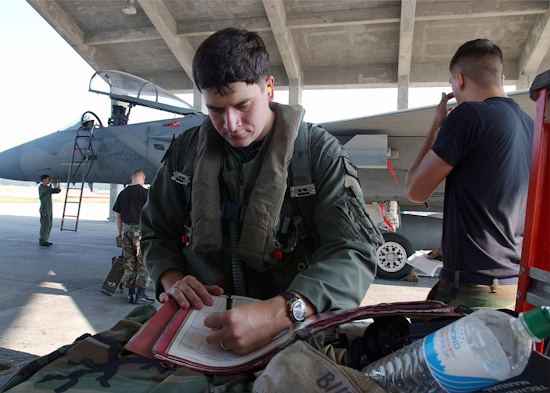
The most important step in becoming an Air Force pilot is receiving a seat assignment.
The seat assignment determines what type of aircraft the pilot will operate during a 10-year service commitment.
The type of aircraft in the Air Force ranges from bombers and fighters to transport planes and military drones (UAVs).
Once new Air Force pilots are assigned a track, they begin to specialize in that aircraft and develop the necessary skills.
Accordingly, it’s not uncommon to continue flight training for the foreseeable future.
Pilots master their aviation skills with years of experience and earn promotions in rank to earn greater responsibility.
The leadership and job skills acquired are second to none and invaluable to future civilian employers.
For now, however, the Air Force pilot must commit to 10 years of military service.
The military commitment is longer than most officer programs yet is a tradeoff of receiving advanced flight training for free.
Air Force pilots must complete 10 years of service from the date they finish entry-level flight school.
Thus, the time spent training and preparing to become an Air Force pilot does not count toward the service commitment.
Airmen are constantly evaluated during their time in service for performance and other expectations.
However, the military pay and benefits are substantial and provide incentives for tackling such a complex role in the military.
Related Article – Air Force Ranks And Pay
Conclusion
Do you want to become a pilot in the Air Force?
Air Force pilots operate some of the most advanced and sophisticated aircraft in the world.
It includes 5th-generation fighters and bombers as well as aerial unmanned vehicle (UAV) operators.
However, before you get your wings, prospective candidates must complete several steps in the application process.
Thus, make sure you begin the process as soon as possible and speak with a local military recruiter.
- Ikon Pass Military Discount: Learn How To Save Big - January 31, 2025
- RTIC Military Discount: Find Out How To Save Big on Gear - January 30, 2025
- Traeger Military Discount: Learn How To Save Big on Smokers - January 28, 2025

